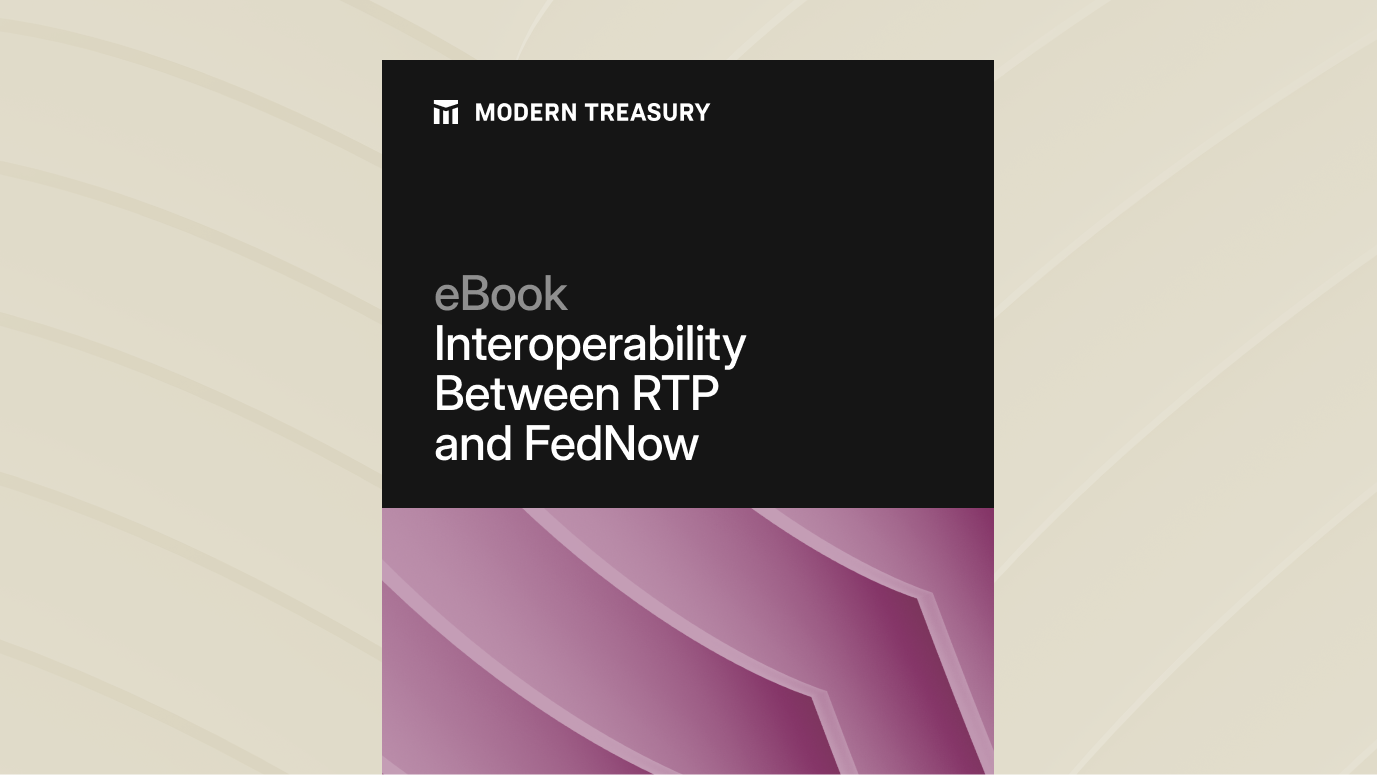Join us at Transfer 2025 to hear how industry leaders are building payments infrastructure for a real-time world.Register Today →
Best Practices for Payment Operations
In this journal, we look at best practices for managing payment operations, namely, building a payments ecosystem to enable transactions and building out the back office to manage the complexities of high volume payments.

Introduction
We’ve written a lot recently about payment operations—the constellation of activities involved in moving money from onboarding counterparties and initiating payments to tracking and reconciling transactions, and everything in between.
As the data from our 2022 State of Payment Operations Report indicates, the urgency for modern payment technology is growing. New technologies are lowering the barriers to entry for embedded payments, and we believe that in the coming years, every payment will begin and end in software. This transformation increasingly calls for automation and a programmatic means of managing transactions at scale.
This sentiment is shared by the market, with 88% of respondents reporting that they are facing problems with their payment system. Unsurprising news, when 8 out of every 10 respondents stated that up to half of their payment operations processes are still manual, and when companies, on average, use 9.5 systems to manage payment operations.
To effectively manage payment operations companies need to be intentional and comprehensive when building out their payment systems. Below, we dive deep into some of the best practices for payment operations, namely: building your payments ecosystem to enable transactions and building your back office payment operations to manage the complexities of high volume payments.
Best Practice #1: A Robust Payments Ecosystem
Building out your payments ecosystem means taking the steps needed to embed payments into your product at scale. From a network perspective this includes handling multiple payments rails and currencies, managing international payouts, and owning bank relationships. This also includes the steps needed to send, receive, and reconcile payments on a single platform.
Automation and Programmability
Embedding payments into your software product effectively requires payment automation and programmability. Best in class payment operations means having:
- REST APIs to set up custom payment initiation flows tailored to your product.
- A web app that enables finance teams to initiate one-off payments with payment order templates, scheduling, and CSV uploads.
- Real-time status updates on payments you initiate and receive made available via the API or webhooks.
- Support for idempotent requests to prevent the same payment from being accidentally made multiple times.
- A sandbox mode that has feature parity with the live environment so that you can develop and test your integration with the API in a risk-free environment.
Multiple Payment Rails
It’s also important for your solution to support multiple payment methods, which differ in terms of cost and speed. In the US, the key electronic payment methods it should support are ACH, wires, RTP, and soon, FedNow.
Multiple payment methods also help if there are issues with bank coverage. There are still a lot of banks in the US that only support ACH. Part of enabling multiple payment rails is owning your bank relationship and having the flexibility of varied payment solutions across bank partners.
International Payments
International Payments capabilities are necessary for businesses that have international customers and vendors. These companies need to send global payouts, and for those doing this at high volume, having alternatives to paying expensive SWIFT wire fees is incredibly valuable. While Third Party Senders can limit your flexibility with international payments, banks such as SVB and J.P. Morgan enable low value cross border payments that provide significant cost savings to customers.
Best Practice #2: Back Office Management
Once you’ve built out your payments ecosystem to handle complex money movement flows, you need to implement the operational tooling required of businesses that move large volumes of payments, namely building your back office payment operations management.
Compliance Programs
Companies building embedded financial products need to have a compliance program because money movement is highly regulated. Federal and state laws require safeguards to prevent money laundering, detect fraud, and identify illicit financing ˈlike drug trafficking, terrorism, and sanctioned entities.
Effective compliance programs require the following:
- Customer Identification: KYC and KYB checks to meet CIP/CDD requirements.
- Sanctions Screens: Verify customer details against OFAC, PEP, SDN watchlists and adverse media databases.
- Fraud Signals: Behavior biometrics and device intelligence to minimize identity theft and account takeovers.
- Custom Risk Thresholds: Fine tune detection criteria for your use case over time with a no-code rules engine.
How you set up your compliance program ultimately depends on your bank partnership model. Options include indirect compliance programs, like using a Third Party Sender or BaaS provider, or direct management through a payment operations platform like Modern Treasury, which lets you work directly with a bank to manage your own compliance program. Working directly with a bank may require a larger upfront investment but has a number of long term advantages, such as faster payment settlement, better visibility, and more control over your funds.
Payee Onboarding
Effective payee onboarding programs feature the following:
- Bank account validation: The most effective way to minimize failed payments is to validate payee account and routing numbers. Plaid, microdeposit verification, and ACH prenotes are common methods to do this.
- Address collection: Some payment methods like wires also require payee address information to be included on the payment request.
- Taxpayer identification: If payouts constitute taxable income for the payee, it also helps to collect and validate tax details like an SSN or EIN during onboarding.
- KYC and KYB information: You may also need to collect additional information for KYC and KYB purposes, like date of birth and employment status, and conduct ID verification.
Payment Controls
Payment controls like approval rules, audit logs, automatic notifications, and roles-based access can streamline the operational aspects of managing payouts at scale. Approval rules let you flag payments based on criteria like amount, payee, payment method, and more, ensuring you have checks in place to catch potentially erroneous payments that can be incredibly costly to the business.
Database Ledger
You need to be able to track balances in real time with a ledger. Ledgers need to provide a reliable source of truth for all transactions taking place in your product. Best in class ledgers contain the following characteristics:
- Built-in safeguards on data entry and handling. Double-entry, immutability, and audit trails.
- Concurrency and Idempotency controls so the same transaction can not take place twice, eliminating incorrect transactions.
- Flexibility to support any use case. Support for multi currencies including cryptocurrencies like Bitcoin, free-form metadata, account categories.
- Single source of truth. As the source of truth the ledger can ingest data from any source—including payment processors, card providers, etc.
Automatic Reconciliation
Reconciliation is essential for a business to understand how completed and in-progress transactions add up to the cash balance in its bank account. Most finance teams try to solve the reconciliation problem with spreadsheets, email and manual examination of bank statements—processes that are inefficient and error-prone.
By automating reconciliation you can match your payments and returns to transactions as they are made available by your bank. Reconciled transactions are reflected in the previous day and intra-day balances available through the API and dashboard, allowing you to reliably monitor cash across all your business bank accounts.
ERP & Accounting Integrations
Integration with accounting and ERP software simplify the accounting process. Automatically sync reconciled payments to your accounting software to close your books instantly at the end of each cycle. This can eliminate the need to manually export and tag data to your accounting system and drastically reduce the time it takes to close your books.
Next Steps
We built Modern Treasury because of the complexities inherent to software-driven payments and the lack of comprehensive solutions in the market. We provide companies with a robust payment operations platform that offers:
- A trusted, proven API and payments operations dashboard that can support complex funds flows and provide customers a seamless user experience.
- Flexibility and expertise to choose the best banking arrangement through a single platform working across multiple geographies, payments rails, and currencies.
- A modular product and fast-moving team that can enable a suite of future financial product launches.
Take control with our payment operations software and APIs and leave the complexity of bank integrations, reconciliation logic, and ERP connections to us. If you want to learn more, talk to a payments advisor.
Try Modern Treasury
See how smooth payment operations can be.







